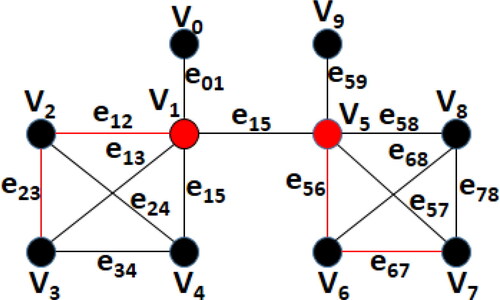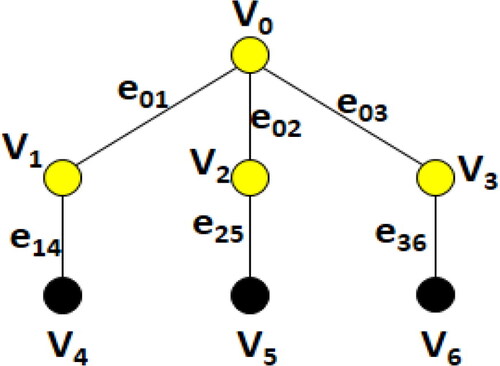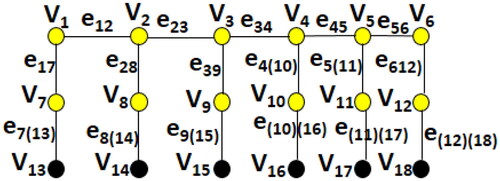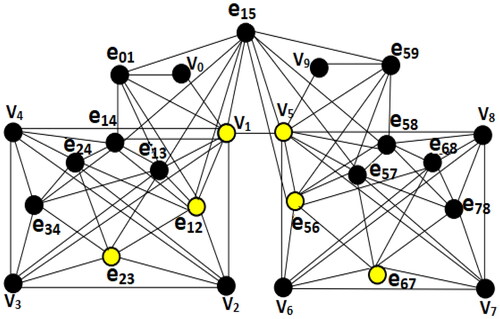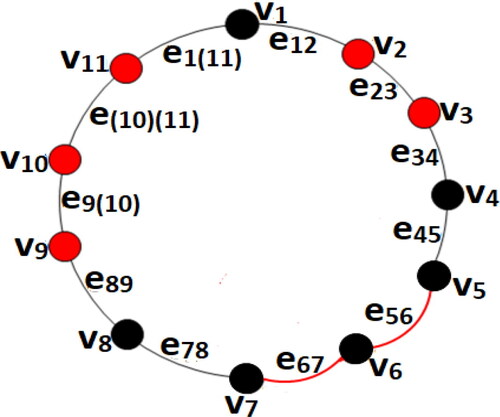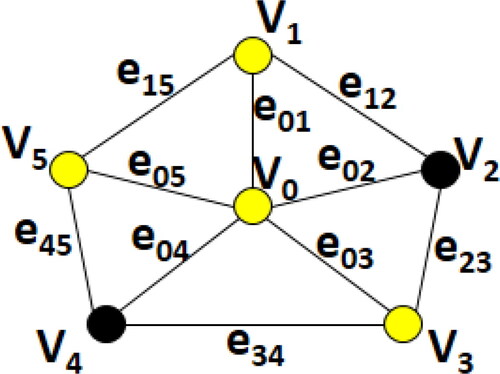 ?Mathematical formulae have been encoded as MathML and are displayed in this HTML version using MathJax in order to improve their display. Uncheck the box to turn MathJax off. This feature requires Javascript. Click on a formula to zoom.
?Mathematical formulae have been encoded as MathML and are displayed in this HTML version using MathJax in order to improve their display. Uncheck the box to turn MathJax off. This feature requires Javascript. Click on a formula to zoom.Abstract
For a graph we call a subset
a total mixed dominating set of G if each element of
is either adjacent or incident to an element of S, and the total mixed domination number of G is the minimum cardinality of a total mixed dominating set of G. In this paper, we initiate to study the total mixed domination number of a connected graph by giving some tight bounds in terms of some parameters such as order and total domination numbers of the graph and its line graph. Then we discuss on the relation between total mixed domination number of a graph and its diameter. Study of this number in trees and 2-corona graphs is our next work. Also we show that the total mixed domination number of a graph is equal to the total domination number of its total graph. Giving the total mixed domination numbers of the paths, cycles, complete bipartite graphs, complete graphs and wheels is our last work.
MSC (2010):
1. Introduction
All graphs considered here are non-empty, finite, undirected and simple. For standard graph theory terminology not given here we refer to [Citation5]. Let be a graph with the vertex set V of order n and the edge set E of size m.
and
denote the open neighborhood and the closed neighborhood of a vertex v, respectively, while
and
denote the minimum and maximum degrees of G, respectively. Also we define
for any vertex v,
and
for any edge e, and
for any element
(T(G) denotes the total graph of G which will define after). For any two vertices u and v in a connected graph G the distance between u and v is the minimum length of a shortest (u, v)-path in G and is denoted by d(u, v). The maximum distance among all pairs of vertices of G is the diameter of G, which is denoted by diam(G). A Hamiltonian path in a graph G is a path which contains every vertex of G.
We write Kn, Cn and Pn for a complete graph, a cycle and a path of order n, respectively, while Wn and
denote the subgraph of G induced by a subset
of G, a wheel of order n + 1, and a complete p-partite graph, respectively. The complement of a graph G, denoted by
is a graph with the vertex set V(G) and for every two vertices v and w,
if and only if
The line graph L(G) of G is a graph with the vertex set E(G) and two vertices of L(G) are adjacent when they are incident in G.
Domination in graphs is now well studied in graph theory and the literature on this subject has been surveyed and detailed in the two books by Haynes, Hedetniemi, and Slater [Citation2, Citation3]. A famous type of them is total domination. The literature on the subject Total domination in graphs has been surveyed and detailed in the recent book [Citation4] by Henning and Yeo.
Definition 1.1.
A subset of a graph G is called a total dominating set, briefly TDS, of G if each vertex of V is adjacent to a vertex in S, and the minimum cardinality of a total dominating set is called the total domination number
of G.
Y. Zhao, L. Kang, and M. Y. Sohn in [Citation6] introduced another domination number as follows.
Definition 1.2.
[Citation6] A subset of a graph G is called a mixed dominating set, briefly MDS, of G if each element of
is either adjacent or incident to an element of S, and the mixed domination number
of G is the minimum cardinality of a mixed dominating set.
Here, we define the concepts of total mixed dominating set and total mixed domination number of a graph.
Definition 1.3.
A subset of a graph G with
is a total mixed dominating set, briefly TMDS, of G if each element of
is either adjacent or incident to an element of S, and the total mixed domination number
of G is the minimum cardinality of a total mixed dominating set.
The goal of this paper is to initiate studying of total mixed domination number of a graph as follows. In Sec. 2, we give some tight lower and upper bounds for the total mixed domination number of a connected graph in terms of some parameters such as the order of the graph or the total domination numbers of the graph and its line graph. Also we discuss on the relation between the total mixed domination number of a graph with its diameter. In Sec. 3, study of total mixed domination number of trees and 2-corona graphs is our first work. Then, we show that the total mixed domination number of a graph is equal to the total domination number of its total graph. In Sec. 4, we will calculate the total mixed domination number of the paths, cycles, complete bipartite graphs, complete graphs and wheels. Finally, in the last section we present some open problems that can be as some motivations for next works on this topic.
Here, we fix a notation for the vertex set, the edge set and open neighborhood of a graph which are used thorough this paper. For a graph G with the vertex set or simply
denotes the edge set of G in which an edge
is denoted by eij. Then
and the edge set of L(G) is the set
A min-TDS/min-TMDS of G denotes a TDS/TMDS of G with minimum cardinality. Also we agree that a vertex v dominates an edge e or an edge e dominates a vertex v mean
Similarly, we agree that an edge dominates another edge means they have a common vertex.
2. Some bounds
Here, we give some tight bounds for the total mixed domination number of a connected graph in terms of some parameters such as order of the graph or the total domination numbers of the graph and its line graph. Also we discuss on the relation between the total mixed domination number of a graph and its diameter. First an observation.
Observation 2.1.
Let G be a graph with the vertex set and
A subset
is a TDS of L(G) if and only if
A TDS
is a TMDS of G if and only if
is independent in G.
Theorem 2.2.
Let G be a connected graph with . Then
and the bounds are tight.
Proof.
Let G be a connected graph with the vertex set and edge set
and let eij denote the edge
Then
Since the union of a TDS of G and a TDS of L(G) is a TMDS of G, we have
To prove the lower bound, let S be a min-TMDS of G. If either every vertex of V is dominated by a vertex in
or every edge of
is dominated by an edge in
then
is a TDS of
respectively, and there is nothing to prove. Otherwise,
is a TDS of G with cardinality at most
Since also by changing the roles of
we may obtain a TDS
with cardinality at most
we have proved
The lower bound is tight for the complete graphs by Propositions 4.6 and 4.7 when
The case
is discussed in Corollary 2.3. To show that the upper bound is tight, consider the graph G illustrated in with
(because
is a min-TDS) and
by Observation 2.1 (because
is a TDS of L(G) and for any set
we have
). Hence it is sufficient to prove
First since
is a TMDS of G, we have
Let
be the subgraphs of G induced by
respectively, which are isomorphic together (see ). And let also S be a TMDS of G such that
By the contrary, let
Since
we have
for some
for some
Hence
is one the sets
for some j = 0, 1, or
for some j = 2, 3, 4, or
for some
or
for some
Since in each case
for some
we conclude
and so
□
Figure 7. The total graph with a min-TDS
and the connected components
that are arranged from left to right where

Corollary 2.3.
For any graph G which has a min-TDS such that its complement is an independent set,
For an example, is the complete bipartite graph
or its derivation
(we recall that the derivation of a graph is the graph which is obtained by replacing every its edge by a path of length 2). In , the set of yellow vertices
is both a min-TDS and a min-TMDS of
The next theorem improves the upper bound given in Theorem 2.2 when either the line graph L(G) has a min-TDS D such that there exist less than disjoint maximal cliques in
or G has a min-TDS S such that the minimum size of vertex cover of
is less than
(recall that a vertex cover of G is a subset
such that each edge of G has a vertex in S and the
denotes the minimum size of a vertex cover of G).
Theorem 2.4.
For any connected graph , let cD be the minimum number of disjoint maximal cliques in
is a min-TDS of L(G), and let
be the minimum size of a vertex cover of
is a min-TDS of G. Then, by the assumptions cL(G) = min{cD | D is a min-TDS of L(G)} and βG = min{β(G\S) | S is a min-TDS of G},
Proof.
We show that the total mixed domination number of G is at most the minimum of the given set, when is a connected graph with
and eij denotes the edge
So
First we prove
Let D be a min-TDS of L(G) such that
Obviously D dominates all elements of
Let
be a subset of
with cardinality
such that every maximal clique of
has exactly one vertex in
and let vi be a vertex that does not dominated by D. Since
is a maximal clique in
we are sure that vi is dominated by the unique vertex which is in
Thus
is a TMDS of G, and so
In a similar way, the inequality
can be proved and this completes our proof. □
As we show in below, our motivation to state Theorem 2.4 is existence of graphs that the upper bound in Theorem 2.4 is better for them than the upper bound in Theorem 2.2. Let Wn be a wheel of order with the vertex set
and the edge set
Then, since
is a min-TDS of
On the other hand,
Hence
Since
by Lemma 2.5, we have
Lemma 2.5.
For any wheel Wn of order
Proof.
Let Wn be a wheel of order with the vertex set
and the edge set
(note: n + 1 is considered 1 to modulo n). Let S be a TDS of
Then
for each
because of
Hence
Now since
is a TDS of
we have
□
Lemma 2.5 shows the upper bound in Theorem 2.4 is tight for any wheel. We know for any graph G with a non-empty edge set, , and Corollary 2.3 characterizes graphs
The next theorem gives a sufficient condition for that the total mixed domination number of a graph be at least 3.
Theorem 2.6.
For any connected graph G of order at least
Proof.
Let be a connected graph with
and
in which
The condition
implies that G has a path P of length at least 4 as an induced subgraph of G. Let S be a min-TMDS of G of cardinality 2. If
for some i, j, then
for some
a contradiction. Also if
for some i, j, k, then
for some
such that
a contradiction. So
□
Now, we present another upper bound for in term of the order of the graph which is tight by Proposition 4.6.
Theorem 2.7.
For any connected graph G of order which has a Hamiltonian path,
Proof.
Let be a Hamiltonian path in a connected graph G of order
Since each of the sets
is a TMDS of G, the result holds. □
3. Trees, 2-corona graphs and total graphs
The facts that show that the converse of Theorem 2.6 is not true in general. But next theorem shows that it holds for trees.
Theorem 3.1.
For any tree of order at least
if and only if
Proof.
By Theorem 2.6, it is sufficient to prove that If
then
and so
If
then
is isomorphic to the complete bipartite graph
and so
by Proposition 4.4. Now let
Then
is a double star tree which is obtained by joining the central vertex v of a tree
and the central vertex w of a tree
Since {v, w} is a TMDS of
we have
□
Next theorem improves the upper bound given in Theorem 2.7 for trees.
Theorem 3.2.
For any tree of order
Proof.
Let be a tree in which
Choose a leaf
and label each vertex of
with its distance from v to modulo 3. This partitions V to the three independent sets
Then by the pigeonhole principle at least one of them, say A0, contains at least one third of the vertices of
and so
We see that every non-leaf and every leaf
is adjacent to some vertex in
If needed, we replace every leaf
by an its neighbour out of
The obtained set S by this way is a TMDS of
Because obviously
for each
and
for each
(because
), and so every
is dominated by
Therefore
□
In the next theorem, we show that for every graph G of order n the total mixed domination number of where
is the 2-corona of G which is obtained from G by adding a path of length 2 to each vertex of G. shows the graph
Theorem 3.3.
For any connected graph G of order
Proof.
Let be a connected graph in which
Then
Since
is a TMDS of
we have
Now let S be a min-TMDS of Then
contains an element wi (because
) for each
Since also every wi must be dominated by an element
and all of the elements
are distinct, we conclude that S includes the set
of cardinality 2n, and so
which completes our proof. For an example, shows
with the min-TMDS
of it. □
By Theorem 3.3 the upper bound in Theorem 3.2 is tight for any 2-corona in which
is a tree of order
The total graph T(G) of a graph is the graph whose vertex set is
and two vertices are adjacent whenever they are either adjacent or incident in G [Citation1]. It is obvious that if G has order n and size m, then T(G) has order n + m and size
and also T(G) contains both
as two induced subgraphs and it is the largest graph formed by adjacent and incidence relation between graph elements. See for an example.
It is clear that a total mixed dominating set of a graph G corresponds with a total dominating set of the total graph Hence we have the next theorem, and so to find the total mixed domination number of a graph we may calculate the total domination number of the total graph of the graph.
Theorem 3.4.
For any graph
As we will see in Proposition 4.1, for an example of Theorem 3.4, while shows a path P12 with a min-TMDS, shows the total graph of the path with the same set as a min-TDS of it.
4. Some classes of graphs
In this section, we present formulas for the total mixed domination number of some known classes of graphs. The first two propositions are devoted to the paths and cycles.
Proposition 4.1.
For any path Pn of order
Proof.
By Theorem 3.4, we calculate the total domination number of is a path of order
in which
and
Then
in which
Claim: There exists a min-TDS with the following three properties.
P.1. if and only if
for each i,
P.2. for each i, perhaps except for i = w,
P.3.
in which are all connected components of the induced subgraph
that are arranged from left to right in
(see for an example).
By proving the claim, each of the sets
will be a min-TDS of
and this completes our proof.
Proof
of the claim: Let S be a min-TDS of We may assume for every
for some i. Because otherwise if
for some i, then we can replace
respectively, that each of them is again a min-TDS of
So we may assume that every connected component of
is a path of order at least 2 whose vertex set is either a subset of V or a subset of
By the minimality of S, we have
for each i. Our proof will be completed by showing that S satisfies the above three property.
P.1: Let and
for some
Then we can replace
which is again a min-TDS of
There is a similar proof when both of
are subsets of
P.2: Since the case has a similar proof, we assume
If for some
then we can replace
and find the min-TDSs
respectively. Now let
for some
Then
by P.1, and
by the minimality of
Then we can replace S by the min-TDS
P.3: Since S is minimum, P.3 holds. □
Proposition 4.2.
For any cycle Cn of order
Proof.
Let be a cycle of order
in which
and
Then
where
In a similar way to the proof of Proposition 4.1, it can be easily verified that the sets
are min-TMDSs of Cn in each case, and this completes our proof. See as an example. □
Propositions 4.1 and 4.2 show that the total mixed domination numbers of a cycle and a path of the same order are roughly same in the following meaning.
Corollary 4.3.
For any integer
In the next step, we calculate the total mixed domination number of a complete bipartite graph.
Proposition 4.4.
For any integers
Proof.
Let be the partition of the vertex set of the complete bipartite graph
to the independent sets
Since
is a TMDS of
we have
Now, by the contrary, let S be a TMDS of with cardinality m. Since the subgraph of
induced by V or U is isomorphic to the empty graphs
respectively, we have
For
we define
Let
and
Since
and so for some
or some
is not dominated by S, we have
Hence both of the sets
and
are nonempty. Because
imply
for some i, and
imply
for some j, which are contradictions. Therefore
for each
for each
(beacause
for some
for some
). Hence
in which
and so
a contradiction. Therefore
See as an example. □
To find the total mixed domination number of a complete graph, we need next lemma.
Lemma 4.5.
Let S be a min-TMDS of a graph in which
. If
, then
Proof.
Let be a graph in which
Let S be a min-TMDS of G and let
For any
we define
If
for each
then
have same cardinality, and so
as desired. Therefore, we assume that there exist two vertices
and continue our proof by induction on
It can be easily verified that for any
with cardinality at most 2, the following inequality Equation(4.0.1)
(4.0.1)
(4.0.1) holds, and we assume it holds for any set of cardinality less than
Then we may assume
for some
By using the induction hypothesis for the set
which has cardinality
we have
(4.0.1)
(4.0.1)
Now by inequality Equation(4.0.1)
(4.0.1)
(4.0.1) and the fact that
our proof will be completed. □
Proposition 4.6.
For any complete graph Kn of order
Proof.
Let Kn be a complete graph with the vertex set and the edge set
First we notice
By Propositions 4.1 and 4.2, we may assume
For any arbitrary TMDS
we show
(4.0.2)
(4.0.2)
If
then
and there is nothing to prove (because otherwise, for any two vertices
out of S, the edge eij can not be dominated by S). Also if
then there exists an edge
for dominating
and so inequality Equation(4.0.2)
(4.0.2)
(4.0.2) holds by Lemma 4.5. Therefore we assume
Let
Then the set
has cardinality at least
(because otherwise, for any two vertices
the edge eij does not dominate by S), and so
by Lemma 4.5. Hence
which implies
Now we discuse on the only remained case Let
Then
and
Since
as desired, we assume
For some
let
be an edge that dominates vn. Then
and so
Hence
by (4.0.1). Now the facts
as desired. On the other hand, since each of the sets
is a TMDS of Kn with the minimum cardinality when
we have proved
For an example, see . □
Before giving the total mixed domination number of a wheel, as we promise in the proof of Theorem 2.2, we show that the lower bound in Theorem 2.2 is tight by Propositions 4.6 and 4.7.
Proposition 4.7.
For any complete graph Kn of order
Proof.
Let be a complete graph of order
with the vertex set
and edge set
Then
For any TDS
let I be the set of all indices of the vertices of S. Obviously for any three indices
because for any
the vertex eij can not be dominated by S. Thus
and since the sets
are TDSs of
in each of the cases, the result holds. □
Proposition 4.8.
For any wheel Wn of order
Proof.
Let be a wheel of order
with the vertex set
and edge set
Since
is a TMDS of Wn, we have
In the sequel, we show Let S be an arbitrary TMDS of Wn. If
then, since
for each
and so
Since we have nothing to prove when
we assume
for some
This implies
(because
), and so
Now let
Then, for dominating every vertex
there exists an edge
for some
By knowing
we conclude S has cardinality at least
which is
for even n and is
for odd n. Since the subgraph of Wn induced by S is connected and
we obtain
is odd, a contradiction. Thus
for odd n.
Thus By assumption
it is sufficient to prove
Let
Since every
must be dominated by an edge
in which
the set
is not empty, and more
because every
is adjacent to at most two edges in
Let
If
then
and so
which implies
as desired.
Therefore we may assume Then
and so
Let
by the contrary. Hence
Since by the assumption
we reach to this contradiction that the subgraph of Wn induced by
isolated vertices, we may assume
Again, since the subgraph of Wn induced by
does not have isolated vertex, we must have
and so
Since obviousely
for even n, let n be odd. Without loss of generality, we assume
and so
By the contrary let Since there is nothing to prove for n = 3 by Proposition 4.6, we assume
For n = 5, since v4 does not dominated by
for some
that is,
But since
does not dominated by S, we reach contradiction. Thus
and so
Therefore, in the sequel, we assume
If
then
where
which imply one of the edges
does not respectively dominated by S, a contradiction. Thus
Let also
So
(4.0.3)
(4.0.3)
Since
we have
Since the subgraph
induced by
dominates the most number of vertices in
when it has as possible as the most number of the complete graphs K2 as induced subgraphs, we conclude that at least two edges of
are needed for dominating every three vertices of
and so
Hence
(4.0.4)
(4.0.4)
Now by knowing
which implies
and by the relations Equation(4.0.3)
(4.0.3)
(4.0.3) and Equation(4.0.4)
(4.0.4)
(4.0.4) , we obtain
and so m = 1. Then
Thus the number of vertices of
dominated by
is at most
which is less than
Therefore
as desired. See for an example. □
5. Some open problems
Problem 5.1.
1. For any graph G, is it true that if and only if it has a min-TDS such that its complement is an independent set of G?
2. Find some families of non-complete graphs
3. Find some families of connected graphs
It can be easily verified that Theorem 2.7 is true for any connected graph of order at most 5. So the existence of a Hamiltonian path in a graph is not a necessary condition in the theorem, and naturally the following problem arises.
Problem 5.2.
Find some other family of graphs G of order
We know for almost all graphs. As we saw in some graphs such as complete graphs and wheels,
for many graphs G. So, we end our paper with the following important problem.
Problem 5.3.
Find some real number such that for any graph
References
- Behzad, M. (1967). A criterion for the planarity of a total graph. Math. Proc. Camb. Phil. Soc. 63(3): 679–681.
- Haynes, T. W., Hedetniemi, S. T., Slater, P. J., eds. (1998). Fundamentals Domination in Graphs. New York: Marcel Dekker, Inc.
- Haynes, T. W., Hedetniemi, S. T., Slater, P. J., eds. (1998). Domination in Graphs: Advanced Topics. New York: Marcel Dekker, Inc.
- Henning, M. A., Yeo, A. (2013). Total Domination in Graphs (Springer Monographs in Mathematics).
- West, D. B. (2001). Introduction to Graph Theory, 2nd ed. USA: Prentice Hall.
- Zhao, Y., Kang, L, Sohn, M. Y. (2011). The algorithmic complexity of mixed domination in graphs. Theor. Comput. Sci. 412(22): 2387–2392.


